译林版(2019)选修第一册Unit 3 On the Move Reading 课件(共19张PPT,内镶嵌视频)
文档属性
| 名称 | 译林版(2019)选修第一册Unit 3 On the Move Reading 课件(共19张PPT,内镶嵌视频) | 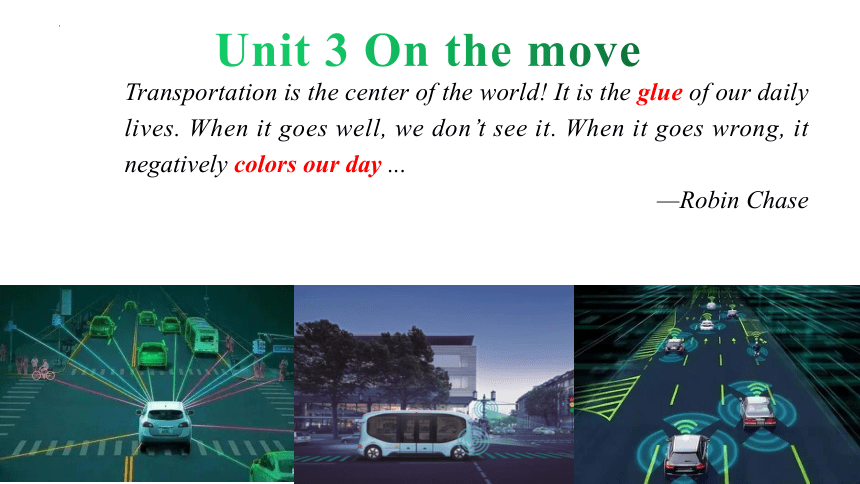 | |
| 格式 | pptx | ||
| 文件大小 | 38.1MB | ||
| 资源类型 | 教案 | ||
| 版本资源 | 牛津译林版(2019) | ||
| 科目 | 英语 | ||
| 更新时间 | 2024-05-31 12:26:10 | ||
图片预览

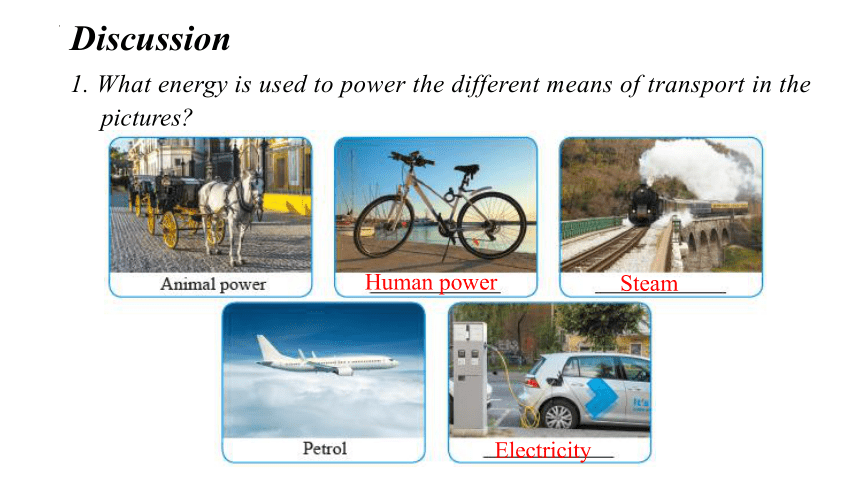

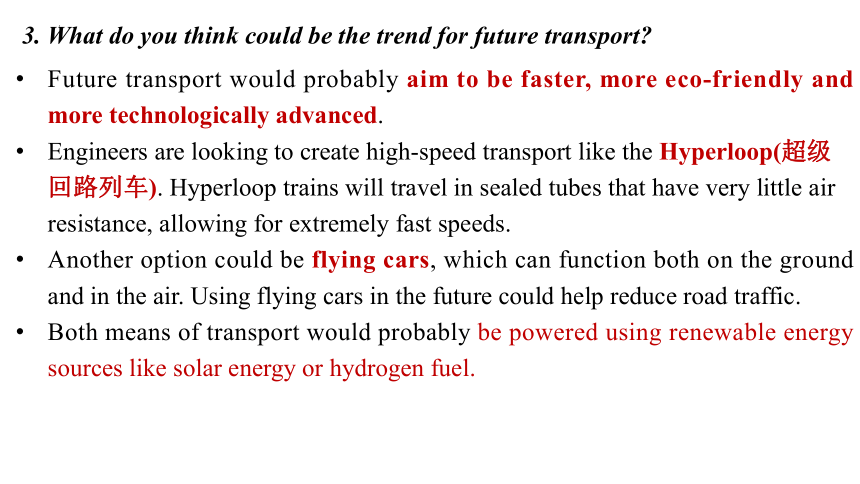
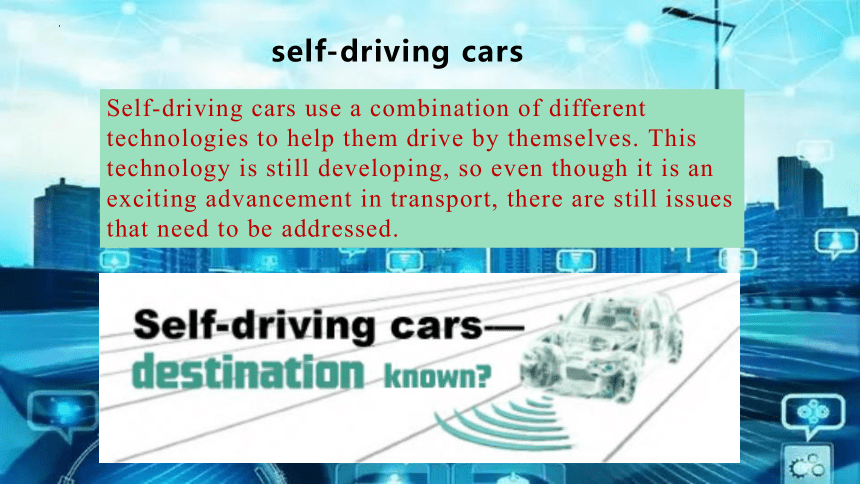
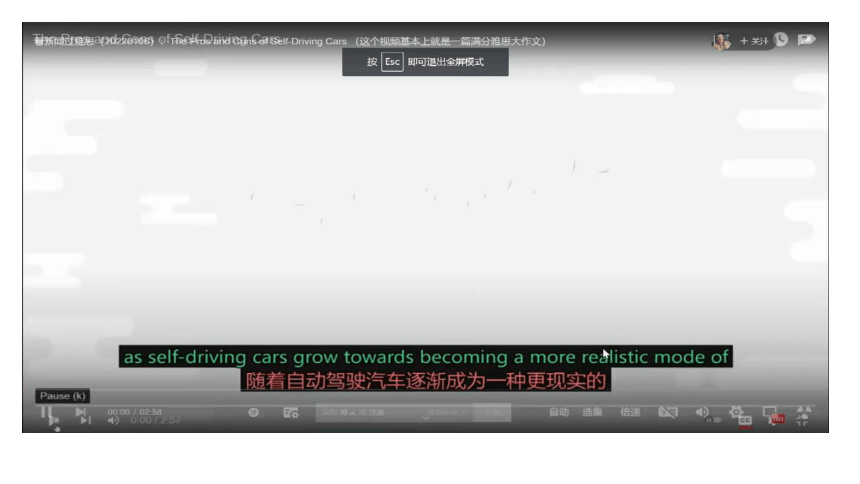
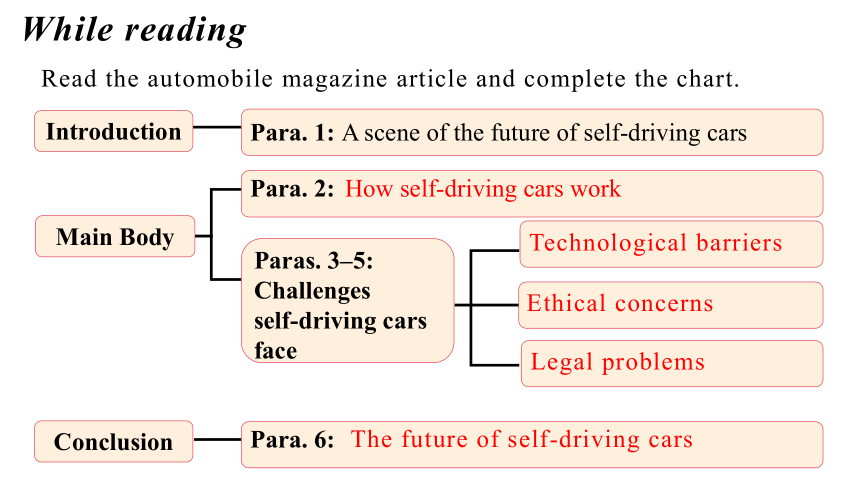
文档简介
(共19张PPT)
Unit 3 On the move
Transportation is the center of the world! It is the glue of our daily lives. When it goes well, we don’t see it. When it goes wrong, it negatively colors our day ...
—Robin Chase
1. What energy is used to power the different means of transport in the pictures
Discussion
Human power
Steam
Electricity
Discussion
according to where they are used:
water transport, underground transport, land transport and air transport
according to its purpose:
passenger transport, freight transport and medical transport like ambulances.
2. What other criteria can you think of to categorize different means of transport
3. What do you think could be the trend for future transport
Future transport would probably aim to be faster, more eco-friendly and more technologically advanced.
Engineers are looking to create high-speed transport like the Hyperloop(超级回路列车). Hyperloop trains will travel in sealed tubes that have very little air resistance, allowing for extremely fast speeds.
Another option could be flying cars, which can function both on the ground and in the air. Using flying cars in the future could help reduce road traffic.
Both means of transport would probably be powered using renewable energy sources like solar energy or hydrogen fuel.
Self-driving cars use a combination of different technologies to help them drive by themselves. This technology is still developing, so even though it is an exciting advancement in transport, there are still issues that need to be addressed.
self-driving cars
While reading
Introduction
Para. 1: A scene of the future of self-driving cars
Conclusion
Main Body
Para. 6:
Para. 2:
Paras. 3–5: Challenges
self-driving cars face
How self-driving cars work
Read the automobile magazine article and complete the chart.
Technological barriers
Ethical concerns
Legal problems
The future of self-driving cars
Para.1
To introduce the topic and provide a likely reality for self-driving cars, also known as autonomous vehicles.
Why does the author describe an imagined scene at the beginning
What might be the benefits of the self-driving cars
energy can be saved. We can spend the time on the way resting in a seat or doing whatever they want.
people do not have to learn how to drive
In that case, even a ninety-year-old healthy man will find it possible to travel across the country in a self-driving car.
Para.2
Cameras as well as sensors like radar and lidar capture a variety of data from the external environment.
Once the data is sent to the AI system, the “brain” of the self-driving car, it is analyzed and put together like a puzzle so that the car can “see” its surroundings and determine its position.
1. How do self-driving cars “see”
Para.2
The AI system identifies patterns from the data and learns from them. An action plan is then created to instruct the car how to “behave” in real time: stay in the lane, move into another one, speed up or slow down. Next, the necessary mechanical controls, such as the accelerator and brakes, are activated by the AI system, allowing the car to move in line with the action plan.
2. How do self-driving cars “behave” appropriately
Para.3
Because road traffic in the real world is so complicated that unfamiliar or unexpected conditions may occur at any time, and it is unreasonable for the database to include every possible object in every possible condition ahead of time.
1. Why is a self-driving car’s perception system likely
to fail
Para.3
In one tragic real-life case, a self-driving car’s perception system failed to identify a white truck against the bright, sunlit sky. It assumed that there was no obstacle in its path and did not activate the brakes, causing the death of the driver in the self-driving car.
2. How did the self-driving car accident happen
Para.4
Whether those in the self-driving car should always be protected first, and whether it should hit a single pedestrian, such as a child or a senior citizen, to avoid crashing into a group of pedestrians.
What ethical choices may self-driving cars face in relation to the Trolley Problem
The moral dilemma that comes with how to ethically program self-driving cars has yet to be resolved.
Para.5
Manufacturing and programming standards have to be agreed upon.
2. What must be done first before law courts can decide who is at fault when self-driving cars are involved in accidents
1. What are the legal situations that the autonomous vehicle industry are confronted with
In this emerging industry, manufacturing and programming standards are not yet uniform. Moreover, the quality and safety of the technology used in self-driving cars is still being challenged.
Para.6
What are the two possible future paths of self-driving cars
Self-driving cars will be allowed to operate without human control, or there will always be human operation, even if limited.
Big data technology has started a (1) ___________ in transport systems, which impacts ways people get around. Devices such as traffic cameras and underground fare gates collect information about drivers’ and passengers’ behaviours, including driving habits in various weather conditions and route choices at different times of day. The data is then analysed by algorithms and exchanged among devices and systems connected through the Internet of Things. Consequently, decisions can be made (2) _________ this mass of data.
revolution
in line with
Revision
revolution dilemma identify in line with
fuel perception be bound to be confronted with
The availability of big data provides considerable advantages for individuals who (3) _________________ the task of planning their travels. They can compare travel information according to their needs like fare, time and walking distance before deciding on which option suits them best. Similarly, drivers can use apps to easily access real-time traffic and parking information, thus avoiding traffic jams and seeking out available parking spaces.
are confronted with
Revision
Revision
On the other hand, big data technology improves the management of public transport systems. Many countries face the (4) __________ between public transport coverage and ridership, as an expanded transport network would mean fewer passengers on a single vehicle. Now these countries can use information collected from GPS and passenger ticket data to (5) ________ patterns in passengers’ route choices and supply bus routes that meet their demands. Bus services are then tailored to offer shorter waiting times and faster routes. Enhancements like this present convenient options to passengers, changing public (6) __________ of transport systems. Furthermore, they offer sustainable long-term solutions which (7) ______________ benefit a country’s economy and environment.
dilemma
identify
perception
are bound to
However, the use of big data (8) ____________ public concern about the protection of personal information. For example, many apps require access to users’ locations without them knowing how the data would actually be used. Therefore, measures must be taken to ensure users’ private information is kept secure.
has fuelled
Revision
Unit 3 On the move
Transportation is the center of the world! It is the glue of our daily lives. When it goes well, we don’t see it. When it goes wrong, it negatively colors our day ...
—Robin Chase
1. What energy is used to power the different means of transport in the pictures
Discussion
Human power
Steam
Electricity
Discussion
according to where they are used:
water transport, underground transport, land transport and air transport
according to its purpose:
passenger transport, freight transport and medical transport like ambulances.
2. What other criteria can you think of to categorize different means of transport
3. What do you think could be the trend for future transport
Future transport would probably aim to be faster, more eco-friendly and more technologically advanced.
Engineers are looking to create high-speed transport like the Hyperloop(超级回路列车). Hyperloop trains will travel in sealed tubes that have very little air resistance, allowing for extremely fast speeds.
Another option could be flying cars, which can function both on the ground and in the air. Using flying cars in the future could help reduce road traffic.
Both means of transport would probably be powered using renewable energy sources like solar energy or hydrogen fuel.
Self-driving cars use a combination of different technologies to help them drive by themselves. This technology is still developing, so even though it is an exciting advancement in transport, there are still issues that need to be addressed.
self-driving cars
While reading
Introduction
Para. 1: A scene of the future of self-driving cars
Conclusion
Main Body
Para. 6:
Para. 2:
Paras. 3–5: Challenges
self-driving cars face
How self-driving cars work
Read the automobile magazine article and complete the chart.
Technological barriers
Ethical concerns
Legal problems
The future of self-driving cars
Para.1
To introduce the topic and provide a likely reality for self-driving cars, also known as autonomous vehicles.
Why does the author describe an imagined scene at the beginning
What might be the benefits of the self-driving cars
energy can be saved. We can spend the time on the way resting in a seat or doing whatever they want.
people do not have to learn how to drive
In that case, even a ninety-year-old healthy man will find it possible to travel across the country in a self-driving car.
Para.2
Cameras as well as sensors like radar and lidar capture a variety of data from the external environment.
Once the data is sent to the AI system, the “brain” of the self-driving car, it is analyzed and put together like a puzzle so that the car can “see” its surroundings and determine its position.
1. How do self-driving cars “see”
Para.2
The AI system identifies patterns from the data and learns from them. An action plan is then created to instruct the car how to “behave” in real time: stay in the lane, move into another one, speed up or slow down. Next, the necessary mechanical controls, such as the accelerator and brakes, are activated by the AI system, allowing the car to move in line with the action plan.
2. How do self-driving cars “behave” appropriately
Para.3
Because road traffic in the real world is so complicated that unfamiliar or unexpected conditions may occur at any time, and it is unreasonable for the database to include every possible object in every possible condition ahead of time.
1. Why is a self-driving car’s perception system likely
to fail
Para.3
In one tragic real-life case, a self-driving car’s perception system failed to identify a white truck against the bright, sunlit sky. It assumed that there was no obstacle in its path and did not activate the brakes, causing the death of the driver in the self-driving car.
2. How did the self-driving car accident happen
Para.4
Whether those in the self-driving car should always be protected first, and whether it should hit a single pedestrian, such as a child or a senior citizen, to avoid crashing into a group of pedestrians.
What ethical choices may self-driving cars face in relation to the Trolley Problem
The moral dilemma that comes with how to ethically program self-driving cars has yet to be resolved.
Para.5
Manufacturing and programming standards have to be agreed upon.
2. What must be done first before law courts can decide who is at fault when self-driving cars are involved in accidents
1. What are the legal situations that the autonomous vehicle industry are confronted with
In this emerging industry, manufacturing and programming standards are not yet uniform. Moreover, the quality and safety of the technology used in self-driving cars is still being challenged.
Para.6
What are the two possible future paths of self-driving cars
Self-driving cars will be allowed to operate without human control, or there will always be human operation, even if limited.
Big data technology has started a (1) ___________ in transport systems, which impacts ways people get around. Devices such as traffic cameras and underground fare gates collect information about drivers’ and passengers’ behaviours, including driving habits in various weather conditions and route choices at different times of day. The data is then analysed by algorithms and exchanged among devices and systems connected through the Internet of Things. Consequently, decisions can be made (2) _________ this mass of data.
revolution
in line with
Revision
revolution dilemma identify in line with
fuel perception be bound to be confronted with
The availability of big data provides considerable advantages for individuals who (3) _________________ the task of planning their travels. They can compare travel information according to their needs like fare, time and walking distance before deciding on which option suits them best. Similarly, drivers can use apps to easily access real-time traffic and parking information, thus avoiding traffic jams and seeking out available parking spaces.
are confronted with
Revision
Revision
On the other hand, big data technology improves the management of public transport systems. Many countries face the (4) __________ between public transport coverage and ridership, as an expanded transport network would mean fewer passengers on a single vehicle. Now these countries can use information collected from GPS and passenger ticket data to (5) ________ patterns in passengers’ route choices and supply bus routes that meet their demands. Bus services are then tailored to offer shorter waiting times and faster routes. Enhancements like this present convenient options to passengers, changing public (6) __________ of transport systems. Furthermore, they offer sustainable long-term solutions which (7) ______________ benefit a country’s economy and environment.
dilemma
identify
perception
are bound to
However, the use of big data (8) ____________ public concern about the protection of personal information. For example, many apps require access to users’ locations without them knowing how the data would actually be used. Therefore, measures must be taken to ensure users’ private information is kept secure.
has fuelled
Revision
同课章节目录
- Unit 1 Food matters
- Welcome to the unit
- Reading
- Grammar and usage
- Integrated skills
- Extended reading
- Project
- Unit 2 The Universal Language
- Welcome to the unit
- Reading
- Grammar and usage
- Integrated skills
- Extended reading
- Project
- Unit 3 The art of painting
- Welcome to the unit
- Reading
- Grammar and usage
- Integrated skills
- Extended reading
- Project
- Unit 4 Exploring poetry
- Welcome to the unit
- Reading
- Grammar and usage
- Integrated skills
- Extended reading
- Project
